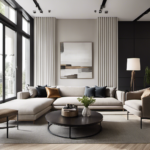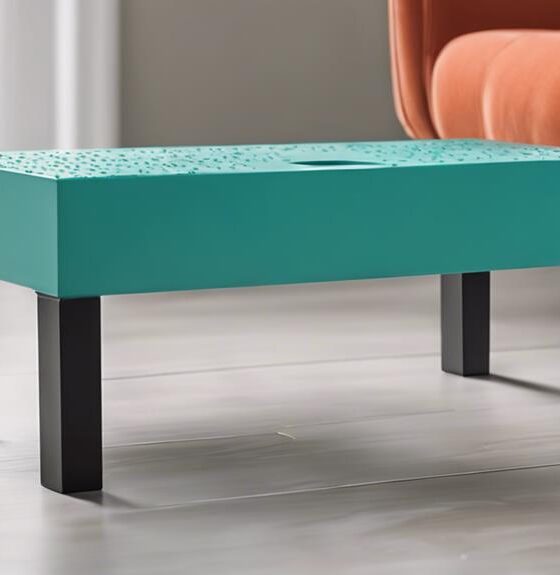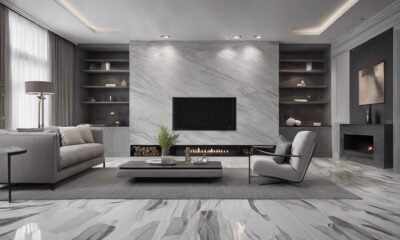Architecture Home Styles
Exploring the Difference Between Modern and Classic Home Decor
Kickstart your journey into the contrasting worlds of modern and classic home decor to discover the unexpected twists that shape your ideal living space.
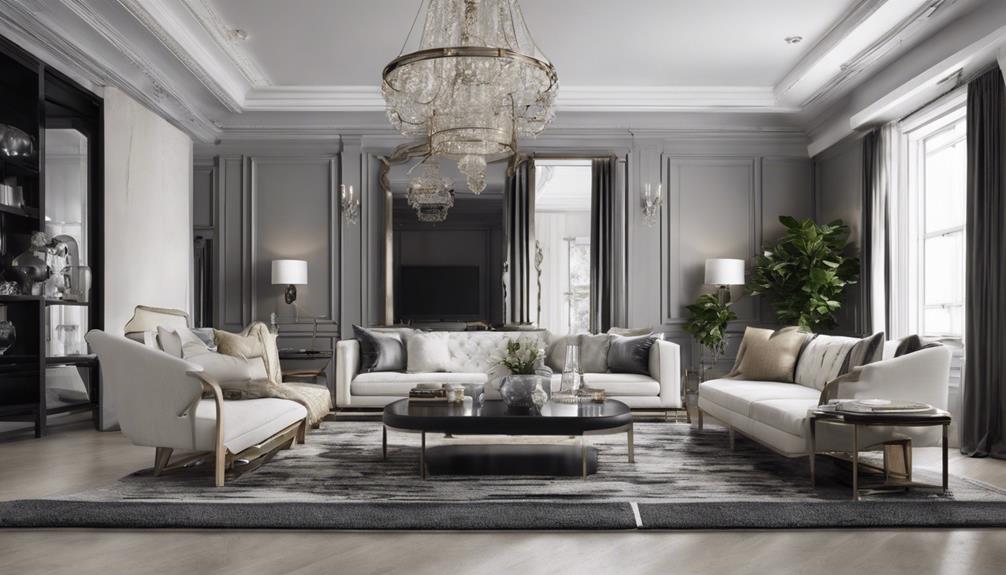
As we navigate the realm of home decor, the distinction between modern and classic styles stands as a fork in the design road, each path offering its own allure. One leads to the sleek, minimalist landscapes of modern design, while the other meanders through the intricate tapestries of classic elegance.
What sets these two apart in terms of ambiance and personal expression may surprise you. Let's unravel the layers of modern and classic home decor to uncover the secrets they hold for crafting your ideal living space.
Key Takeaways
- Modern home decor focuses on clean lines, minimalism, and technology integration.
- Classic home decor emphasizes ornate details, rich woods, and plush fabrics.
- Combining traditional warmth with modern simplicity creates a timeless and inviting space.
- Personalizing decor with unique elements like family mementos and customized color schemes enhances the home.
Characteristics of Modern Home Decor
Modern home decor, with its emphasis on clean lines, minimalistic furniture, and a focus on functionality, embodies a contemporary elegance that resonates with the desire for sleek, clutter-free living spaces. This design style deviates from the ornate and intricate detailing of Traditional interiors, opting instead for simplicity and sophistication.
In Modern design, furniture pieces are often sleek and geometric, contributing to a sense of openness and fluidity within a space. Neutral color palettes like whites, grays, and blacks dominate the Modern interior landscape, creating a canvas that allows for pops of color through decor and art. The integration of technology is a hallmark of Modern decor, with smart home features seamlessly blending into the overall design.
Sustainability is another key aspect, with eco-friendly materials and energy-efficient solutions being prioritized. Modern design celebrates open spaces, natural light, and a harmonious balance between form and function, making it a popular choice for those seeking a contemporary aesthetic.
Elements of Classic Home Decor
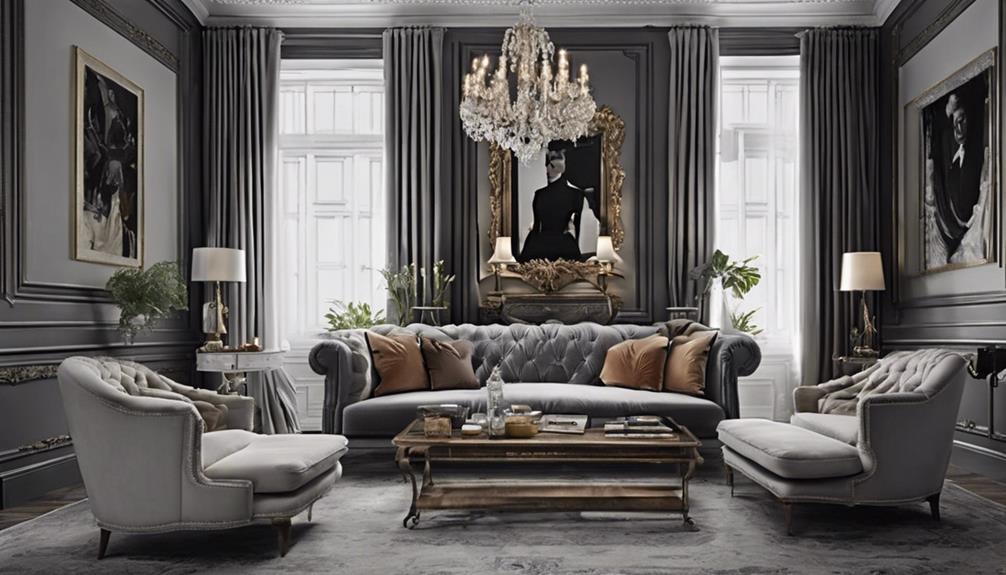
Embracing the essence of time-honored elegance and opulence, classic home decor showcases a distinct charm through its elaborate moldings, rich woods, and plush fabrics. Symmetrical patterns are meticulously incorporated to create a sense of order and attention to detail, enhancing the overall grandeur of the space. Heavy furniture pieces, often ornate and intricate, take center stage, prioritizing form over function in classic home decor. The warm color palette frequently used in this style cultivates a cozy and inviting atmosphere, enveloping visitors in a sense of comfort and nostalgia.
| Elements of Classic Home Decor | Description |
|---|---|
| Elaborate Moldings | Intricate and ornate trimmings that adorn walls and ceilings. |
| Rich Woods | Luxurious wooden furniture and fixtures adding warmth and elegance. |
| Plush Fabrics | Soft and lavish materials like velvet and silk for upholstery and drapery. |
| Symmetrical Patterns | Balanced designs that reflect a meticulous attention to detail and order. |
Design Influences on Home Decor
Transitioning from the intricate details of classic home decor, design influences on home decor encompass a broad spectrum of styles and trends that shape the way we create and personalize our living spaces.
Modern design, with its minimalist principles and emphasis on clean lines, influences contemporary styles by promoting simplicity and functionality. In contrast, traditional design draws inspiration from historical elements, showcasing ornate patterns and traditional finishes that evoke a sense of timeless elegance.
Interior design today often combines aspects of modern and classic decor to create unique spaces that reflect individual tastes. Modern furniture pieces are favored for their sleek designs and ability to complement various color schemes, while classic elements like rich colors and luxurious textures add depth and sophistication to a room.
Furthermore, the trend towards open spaces in modern design has influenced how we arrange furniture and envision our living areas, emphasizing a sense of flow and connectivity within the home. These design influences continually shape the way we perceive and interact with our living environments, offering a blend of tradition and innovation for a truly personalized aesthetic.
Incorporating Modern and Classic Styles

Incorporating a harmonious blend of modern and classic styles in home decor elevates the aesthetic appeal and creates a timeless charm that resonates with personal tastes and preferences. When merging traditional design elements with modern design concepts, one can achieve a truly unique and captivating interior.
Here are three key ways to seamlessly integrate traditional and modern styles:
- Blend Traditional Colors with Contemporary Interior: Combining classic color palettes and patterns with sleek, modern furniture can create a striking visual contrast that adds depth and character to the space.
- Integrate Vintage Pieces with Contemporary Furnishings: Mixing vintage or antique decor items with contemporary pieces brings a sense of history and character to a room, enhancing its overall appeal.
- Achieve a Balance Between Traditional and Modern Touch: Striking a balance between the warmth of traditional decor and the clean lines of modern design ensures a versatile and inviting atmosphere that's both stylish and functional.
Creating a Personalized Home Decor Style
Our home decor style becomes a reflection of our unique personality and preferences, shaping a space that is distinctly ours. Incorporating personal mementos, customizing color schemes, furniture arrangements, and mixing traditional with modern elements all play a crucial role in creating a personalized living space that speaks to who we are. By adding personal mementos, such as family photos or heirlooms, we infuse our decor with sentimental value and memories. Choosing the right color schemes and furniture arrangements allows us to express our style and create a harmonious atmosphere. Accessories like artwork or decorative pieces add a unique touch to the space. The table below showcases how mixing elements and expressing personality through decor choices can transform a house into a personalized and inviting home.
| Elements | Description | Emotion |
|---|---|---|
| Personal Mementos | Family photos, heirlooms | Sentimental |
| Color Schemes | Customized palettes | Vibrant |
| Furniture Arrangements | Unique layouts | Cozy |
| Accessories | Artwork, decorative pieces | Stylish |
| Mixing Elements | Traditional with modern | Eclectic |
Frequently Asked Questions
What Is the Difference Between Modern and Classic Home Decor?
When comparing modern and classic home decor, one can discern a stark contrast in design principles, color schemes, and overall ambiance.
Modern decor boasts clean lines, minimalism, and neutral hues for a sleek and uncluttered feel.
In contrast, classic decor showcases ornate details, rich colors, and traditional patterns, emanating warmth and elegance.
The distinction lies in the fusion of simplicity and functionality versus traditional elements and opulence.
How Do You Mix Modern and Classic Decor?
When mixing modern and classic decor, we emphasize blending traditional elements like ornate details and warm colors with modern aesthetics like clean lines and neutral tones.
This fusion creates a harmonious balance between old-world charm and sleek modernism, incorporating classic patterns and textiles to add depth.
A cohesive color scheme ties everything together, while statement pieces merging traditional craftsmanship with modern design serve as stunning focal points.
What Is the Difference Between Modern Design and Classic Design?
When we compare modern design to classic design, the distinction lies in their essence. Modern design embraces simplicity, clean lines, and minimalism, deriving inspiration from the early to mid-20th century.
In contrast, classic design showcases ornate details, rich colors, and traditional patterns, drawing from the opulence of Western European 18th-19th-century décor. The former prioritizes functionality and neutral hues, while the latter exudes historical richness and warmth.
What Is the Difference Between Contemporary and Traditional Decor?
Well, folks, when it comes to contemporary versus traditional decor, we've got two different worlds colliding!
Traditional decor is all about the ornate details, rich colors, and luxurious fabrics, giving off that classic and timeless vibe.
On the flip side, contemporary decor is all about simplicity, clean lines, and minimalism, showcasing the latest trends and innovative materials.
Conclusion
As we navigate the world of home decor, we're reminded that 'simplicity is the ultimate sophistication.'
Embracing the differences between modern and classic styles allows us to create a personalized space that reflects our unique tastes and preferences.
Whether we choose clean lines and muted colors or rich details and traditional patterns, our homes become a reflection of our personalities and a sanctuary where comfort meets style.
In the end, it's all about finding the perfect balance that brings us joy and serenity.
- About the Author
- Latest Posts
Introducing Ron, the home decor aficionado at ByRetreat, whose passion for creating beautiful and inviting spaces is at the heart of his work. With his deep knowledge of home decor and his innate sense of style, Ron brings a wealth of expertise and a keen eye for detail to the ByRetreat team.
Ron’s love for home decor goes beyond aesthetics; he understands that our surroundings play a significant role in our overall well-being and productivity. With this in mind, Ron is dedicated to transforming remote workspaces into havens of comfort, functionality, and beauty.
Architecture Home Styles
Architectural Shingles: Do They Really Last Long for 30 Years?
Uncover the truth behind architectural shingles' 30-year durability claim and find out if they truly stand the test of time.
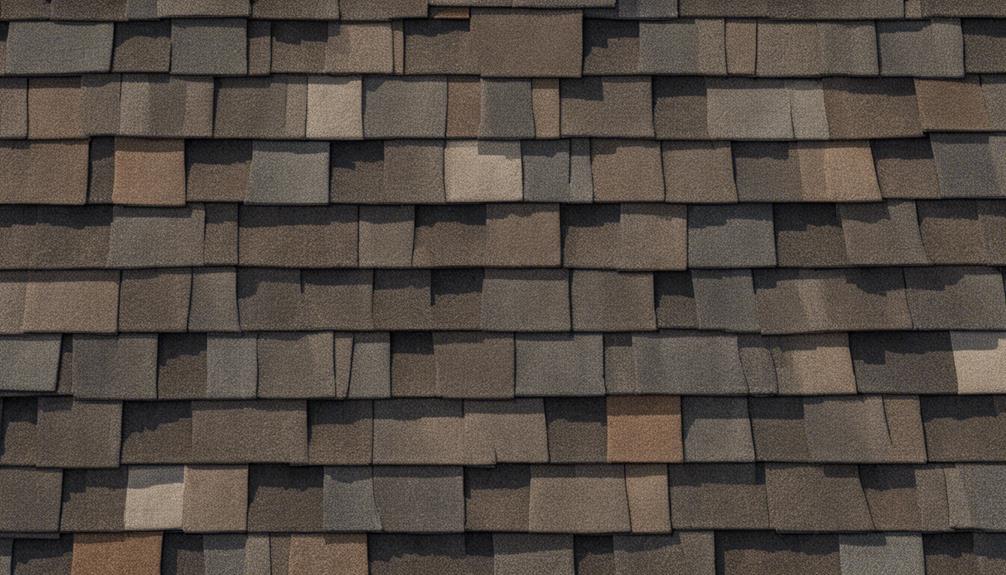
As we watched the sunset over the horizon, it reminded us of the durability advertised for architectural shingles. They claim they can withstand the test of time for 30 years.
However, have you ever wondered if this promise holds true in reality? Let's explore the intriguing world of architectural shingles and uncover whether they truly stand the test of time as advertised or if there's more to the story than meets the eye.
Key Takeaways
- Architectural shingles typically last around 22-25 years, not the full 30-year warranty period.
- Proper installation, ventilation, and maintenance impact shingle longevity.
- Weather conditions and shingle type influence architectural shingle lifespan.
- Skilled contractors play a crucial role in maximizing architectural shingle longevity.
Lifespan of Architectural Shingles
In real-world conditions, architectural shingles typically last around 22-25 years, slightly below their marketed longevity of 30 years. The lifespan of architectural shingles is influenced by various factors such as proper installation, ventilation, maintenance, and the presence of water buildup.
Skilled roofing contractors are instrumental in ensuring that the shingles are installed correctly, maximizing their durability. Adequate ventilation helps regulate the temperature under the shingles, preventing excessive heat that can degrade the materials over time. Regular maintenance, including keeping the roof clean to avoid water buildup and promptly addressing any damaged shingles, can significantly extend the lifespan of architectural shingles.
Recognizing signs of wear and tear, like missing, cracked, curled, or faded shingles, leaks, or an aging roof nearing its expected lifespan, is crucial. These signs indicate the need for replacement to prevent further damage to the roof structure. Engaging experienced roofing contractors for timely assessments and replacements is essential to maintain the integrity of the roof and optimize the longevity of architectural shingles.
Factors Influencing Shingle Longevity

Factors that influence the longevity of architectural shingles encompass proper installation, ventilation, and regular maintenance, all crucial components in extending their lifespan. The roofing materials used, particularly the type of asphalt shingle roof, significantly impact the lifespan of architectural shingles. Different types of asphalt shingles have varying durability levels, affecting how long they can last.
Skilled contractors play a vital role in ensuring the proper installation of architectural shingles, which is essential for their longevity. Adequate ventilation is crucial as it helps regulate temperature and moisture levels, preventing premature deterioration. Weather conditions also play a significant role in determining how long architectural shingles will last, with harsh climates potentially shortening their lifespan.
Regular inspections and roof maintenance are key in identifying and addressing issues promptly, prolonging the life of architectural shingles. By considering these factors and ensuring proper installation, ventilation, and maintenance, the lifespan of architectural shingles can be maximized.
Maintenance Tips for Longevity
To optimize the longevity of architectural shingles, prioritizing regular maintenance is essential, encompassing tasks such as cleaning debris, ensuring proper ventilation, and promptly addressing any shingle damage. Proper maintenance plays a crucial role in extending the lifespan of architectural shingles. Here are some key maintenance tips to help preserve the integrity of your roof:
- Regular Cleaning: Removing debris such as leaves, branches, and dirt from the roof surface prevents moisture buildup and potential damage to the shingles.
- Ventilation Check: Ensure that the attic and roof spaces are adequately ventilated to prevent heat and moisture buildup, which can lead to premature deterioration of the shingles.
- Timely Repairs: Promptly repair any damaged or missing shingles to prevent water infiltration and further structural issues.
Signs for Shingle Replacement
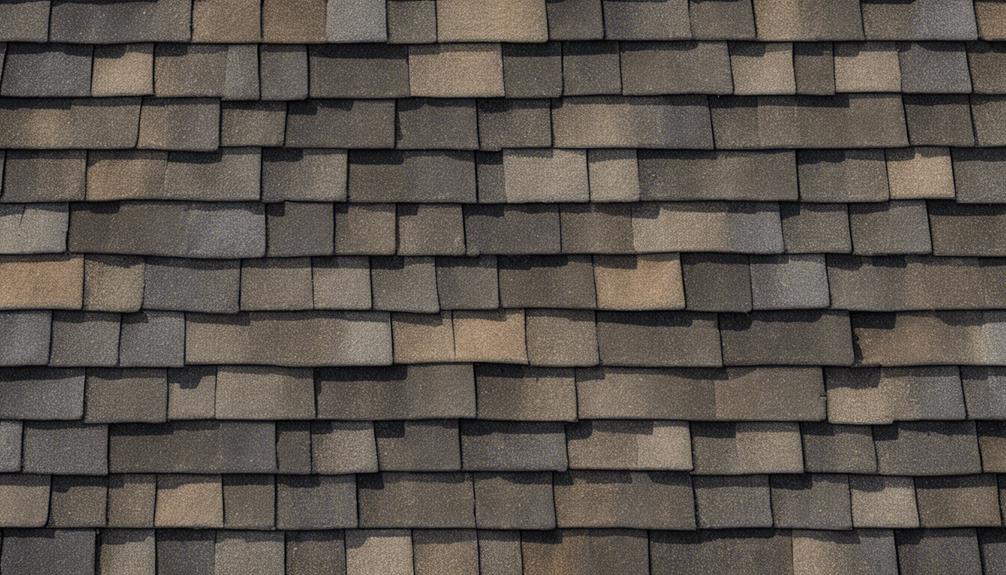
When evaluating the condition of architectural shingles, it's crucial to observe for visible signs such as missing, cracked, or curled shingles that may necessitate replacement. These signs not only compromise the aesthetic appeal of the roof but also indicate potential damage that could lead to leaks and impact the roof's integrity. Additionally, visibly worn or faded shingles suggest aging and may require replacement to maintain the roof's longevity. It's essential to recognize these signs early on to prevent further damage and ensure the overall lifespan of the roof.
Roofing contractors play a vital role in assessing shingle damage and determining the need for replacement. Leaks in the roof, often stemming from shingle issues, are a clear indicator that replacement is necessary to avoid structural damage. As roofs age and near the end of their expected lifespan, it becomes increasingly important to monitor and address any signs of shingle damage promptly. By staying vigilant and acting swiftly, homeowners can ensure the durability and performance of their roofs.
Warranty Considerations for Architectural Shingles
Observing the longevity and warranty aspects of architectural shingles provides homeowners with essential insights into ensuring the durability and protection of their roofs.
- Warranty Coverage: Architectural shingles are often advertised with 30-year warranties, but real-world conditions typically see them lasting around 22-25 years. Warranty coverage usually protects against manufacturing defects for a specific period but may exclude labor costs.
- Maintenance Impact: Regular maintenance, proper installation, and adequate ventilation are critical factors influencing the lifespan of architectural shingles beyond the warranty period.
- Contractor Expertise: Skilled contractors play a crucial role in enhancing the longevity of architectural shingles through precise installation techniques and consistent maintenance practices.
Understanding the limitations of warranties and the importance of proactive maintenance can significantly extend the lifespan of architectural shingles. By prioritizing these considerations, homeowners can maximize the protection and value that architectural shingles bring to their roofing investments.
Frequently Asked Questions
How Long Do 30 Year Architectural Shingles Really Last?
They typically last around 22-25 years in real-world conditions. Factors like installation quality, ventilation, weather, and maintenance impact their lifespan. Proper installation by a skilled contractor and regular maintenance help extend their longevity.
Maintenance practices, such as keeping the roof clean and repairing damaged shingles promptly, are crucial. Signs for replacement include missing, cracked, curled shingles, leaks, and an aging roof near its expected lifespan.
Are 30 Year Shingles Worth It?
Yes, 30-year shingles are worth the investment due to their durability and protection. While they may not always reach the full 30-year mark in real-world conditions, they still provide significant longevity and value.
In our experience, the benefits of enhanced weather resistance and aesthetic appeal outweigh any slight variance in lifespan. Proper installation and maintenance practices can ensure that these shingles perform admirably for decades.
Do 40 Year Shingles Really Last 40 Years?
Yes, 40-year shingles are designed to last longer than standard options, but factors like installation quality and climate influence their actual lifespan.
While they may not always reach the full 40-year mark, these architectural shingles generally offer superior durability compared to lower-grade alternatives.
Regular maintenance and prompt repairs can help maximize their longevity.
It's crucial to consider these variables when assessing the practical lifespan of 40-year shingles.
Are 30 Year Architectural Shingles Impact Resistant?
Yes, 30-year architectural shingles can offer impact resistance, with ratings varying based on quality and testing. Higher-rated shingles, like Class 4, provide superior protection against hail and debris, increasing durability and weather resilience.
Understanding these ratings is vital for selecting the best shingle for your home. Inspecting the manufacturer's specifications and quality standards will help ensure you choose impact-resistant 30-year architectural shingles that meet your needs.
Conclusion
After conducting thorough research and analysis, it's evident that the claim of architectural shingles lasting for 30 years is often exaggerated. While they're marketed as such, the reality is that various factors influence their lifespan, typically ranging from 22-25 years.
By understanding these factors, implementing proper maintenance practices, and promptly addressing signs of wear, homeowners can effectively prolong the longevity of their architectural shingles beyond the advertised timeframe.
- About the Author
- Latest Posts
Introducing Ron, the home decor aficionado at ByRetreat, whose passion for creating beautiful and inviting spaces is at the heart of his work. With his deep knowledge of home decor and his innate sense of style, Ron brings a wealth of expertise and a keen eye for detail to the ByRetreat team.
Ron’s love for home decor goes beyond aesthetics; he understands that our surroundings play a significant role in our overall well-being and productivity. With this in mind, Ron is dedicated to transforming remote workspaces into havens of comfort, functionality, and beauty.
Architecture Home Styles
How Long Do 30-Year Architectural Shingles Really Last: A Maintenance Guide
Solve the mystery of 30-year architectural shingles' lifespan and discover crucial maintenance tips to ensure their longevity.
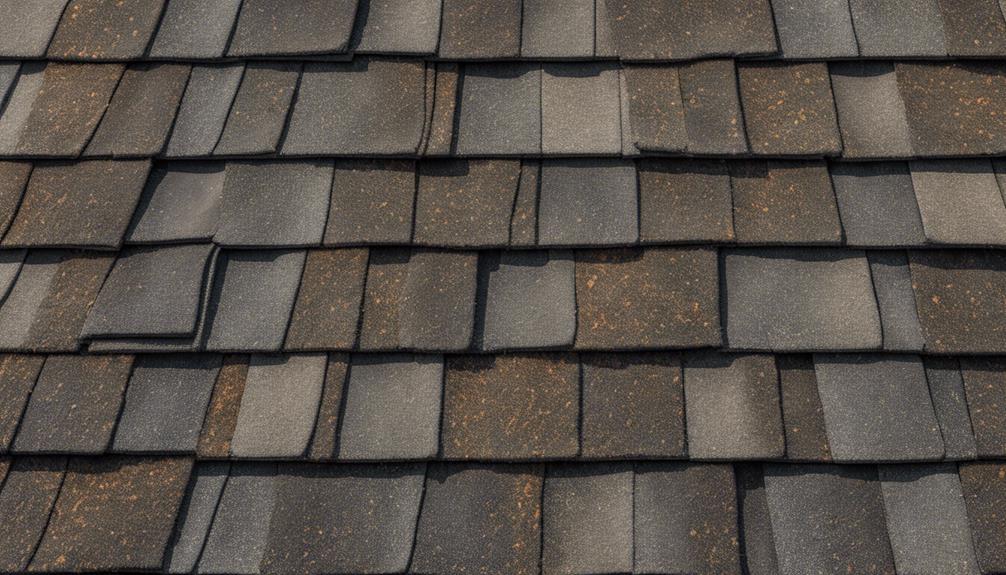
When it comes to 30-year architectural shingles, there's a common misconception about their actual lifespan that many homeowners might not be aware of.
Have you ever wondered if these shingles truly stand the test of time as advertised?
Let's uncover the reality behind the longevity of these roofing materials and explore essential maintenance practices that can make a significant difference in preserving their durability.
Key Takeaways
- Skilled installation and proper ventilation enhance architectural shingle longevity.
- Regular inspections and prompt repairs prolong shingle lifespan.
- Signs like missing or cracked shingles indicate the need for replacement.
- Effective maintenance practices like debris removal and tree trimming extend shingle performance.
Lifespan of 30-Year Architectural Shingles
In real-world conditions, 30-year architectural shingles typically last approximately 22-25 years. The lifespan of these shingles is heavily influenced by factors such as installation quality, ventilation, weather conditions, and maintenance practices. For optimal longevity, it's crucial to ensure that the shingles are installed correctly by a skilled contractor. Proper installation not only enhances the durability of the shingles but also contributes to maintaining their structural integrity over time.
Moreover, adequate ventilation plays a significant role in extending the lifespan of 30-year architectural shingles. Good ventilation helps regulate temperature and moisture levels in the attic, preventing issues like mold growth and premature deterioration of the shingles. Regular maintenance, including inspections and timely repairs, is also essential for prolonging the life of these shingles. By addressing any issues promptly, homeowners can prevent minor problems from escalating and causing extensive damage to the roof. Understanding these key factors is essential for maximizing the lifespan of 30-year architectural shingles in real-world conditions.
Factors Affecting Shingle Longevity

Factors affecting the longevity of architectural shingles, including installation quality, ventilation, weather conditions, and maintenance practices, play crucial roles in determining the lifespan of these roofing materials. Proper installation by a skilled contractor is essential for ensuring that the shingles are placed correctly, preventing premature wear and damage. Adequate ventilation helps regulate temperature and moisture levels, reducing the risk of mold growth and shingle deterioration. Weather conditions, such as extreme heat, cold, or storms, can impact the shingles differently based on their direction and exposure. Regular maintenance, like cleaning the roof, promptly repairing damaged shingles, and trimming overgrown branches, can significantly extend the shingle lifespan.
To protect and prolong the durability of architectural shingles, homeowners should conduct regular inspections to identify signs of wear or damage early on. By implementing effective maintenance strategies and addressing issues promptly, individuals can maximize the lifespan of their shingles and ensure long-term roof protection.
Extending Architectural Shingle Lifespan
Regular maintenance practices significantly impact the lifespan of 30-year architectural shingles. To extend the longevity of architectural shingles, implementing regular inspections, roof repairs, proper ventilation, and protection measures is crucial. Here is a breakdown of key practices to help maintain and extend the lifespan of architectural shingles effectively:
| Maintenance Tips | Description | Importance |
|---|---|---|
| Regular Inspections | Scheduled assessments for damage detection | Ensures early repairs |
| Roof Repairs | Prompt fixing of damaged shingles | Prevents further issues |
| Ventilation | Proper airflow to regulate temperature and moisture | Enhances durability |
| Tree Branches | Trimming to prevent damage from falling debris | Protects shingles |
Signs for Replacing Architectural Shingles
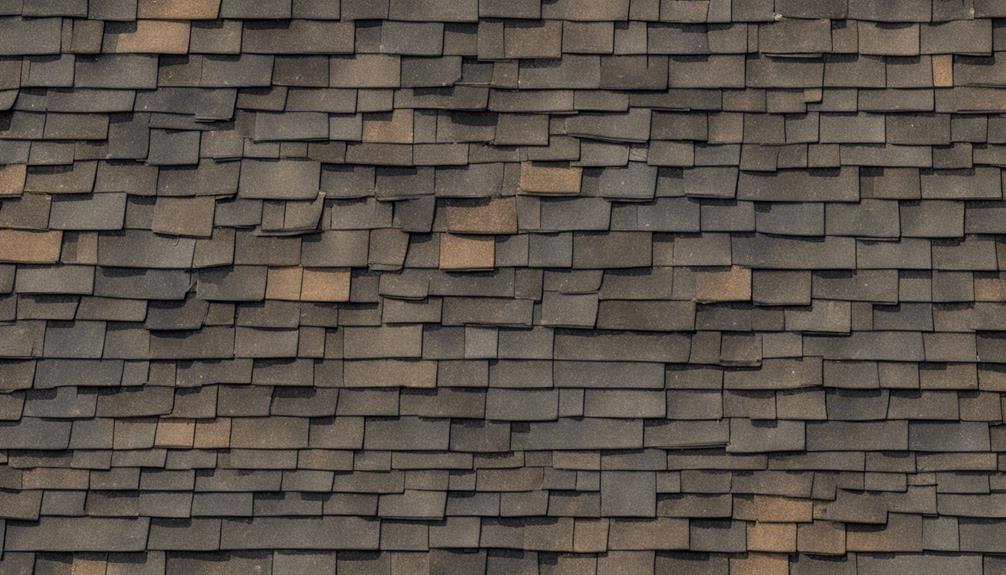
To identify when replacement is necessary for architectural shingles, attentive observation of key indicators like missing, cracked, or curled shingles is essential. When assessing the state of your roof, keep an eye out for the following signs that may indicate it's time for a roof replacement:
- Missing Shingles: Any gaps in your asphalt shingle pattern can leave your roof vulnerable to leaks and further damage.
- Cracked Shingles: Cracks compromise the structural integrity of the shingles, making them less effective at protecting your roof.
- Curled Shingles: Shingles that are curling upwards are a clear sign of aging and wear, suggesting they're no longer providing adequate protection.
- Worn Appearance: If your shingles appear visibly worn or faded, it may be time to consider a replacement to maintain the integrity of your roof.
- Leaks: Water entering your home through the roof is a clear indication of damage that may require immediate attention to prevent further issues.
Maintenance Tips for Architectural Shingles
For optimal longevity and performance of your architectural shingles, meticulous attention to regular maintenance tasks is crucial. Regular inspections play a pivotal role in identifying any issues early on, allowing for prompt repairs that can prevent further damage and extend the lifespan of your 30-year architectural shingles.
Ensuring that your shingle roof is free of debris and moss buildup is essential in maintaining its structural integrity. Regular debris removal not only improves the aesthetic appeal of your roof but also prevents potential water damage. Additionally, trimming overgrown tree branches near your roof is vital to preventing any physical damage to the architectural shingles.
Frequently Asked Questions
How Long Do 30 Year Architectural Shingles Really Last?
They typically last around 22-25 years, influenced by factors like installation quality, ventilation, and maintenance. Proper installation and ventilation play vital roles in shingle longevity.
A skilled contractor and regular maintenance can extend their lifespan. Regular inspections and maintenance are crucial in maximizing the life of 30-year architectural shingles.
How Often Should Architectural Shingles Be Replaced?
Architectural shingles should be replaced roughly every 22-25 years due to wear and tear. Factors like weather, maintenance, and installation quality impact their lifespan.
Regular inspections and maintenance can help determine when replacement is needed, ensuring your roof remains in good condition.
Are 30 Year Architectural Shingles Impact Resistant?
Yes, 30-year architectural shingles can vary in impact resistance.
While some standard options lack this feature, certain manufacturers offer impact-resistant versions or coatings.
These enhanced shingles provide increased durability against hail and debris, making them ideal for regions prone to severe weather.
Homeowners should consider investing in impact-resistant architectural shingles for added protection and longevity.
How Long Are Architectural Shingles Guaranteed For?
We guarantee that architectural shingles last 30 years. This assurance reflects the quality and durability of these shingles, ensuring their performance over time.
Manufacturers support this longevity with a 30-year warranty, offering homeowners peace of mind. Trust in the manufacturer's promise for the lifespan of your architectural shingles.
Conclusion
In conclusion, it's crucial to understand that while 30-year architectural shingles may not always live up to their advertised lifespan, proper maintenance and care can significantly extend their durability.
By staying vigilant and proactive in inspecting, repairing, and maintaining these roofing materials, homeowners can ensure that their investment lasts longer than expected.
Remember, a stitch in time saves nine – so don't wait until it's too late to protect your home from the elements.
- About the Author
- Latest Posts
Introducing Ron, the home decor aficionado at ByRetreat, whose passion for creating beautiful and inviting spaces is at the heart of his work. With his deep knowledge of home decor and his innate sense of style, Ron brings a wealth of expertise and a keen eye for detail to the ByRetreat team.
Ron’s love for home decor goes beyond aesthetics; he understands that our surroundings play a significant role in our overall well-being and productivity. With this in mind, Ron is dedicated to transforming remote workspaces into havens of comfort, functionality, and beauty.
Architecture Home Styles
Building Out: Wood or Metal – Which Is Cheaper?
Pondering the cost differences between wood and metal buildings? Explore the intriguing factors that affect their affordability and long-term savings.
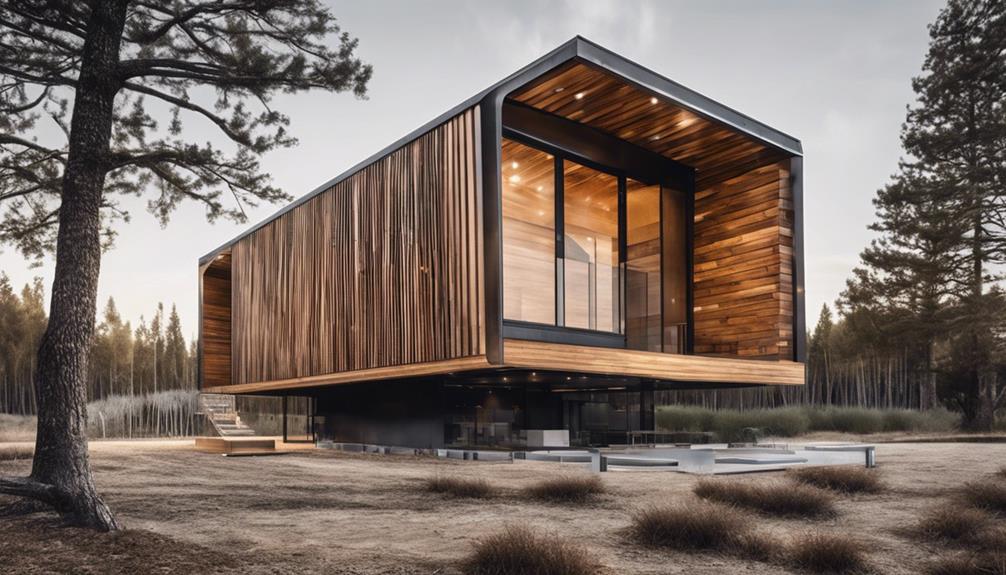
As we delve into the realm of construction costs, it's fascinating to note that metal buildings can offer a more economical option compared to their wooden counterparts.
The initial expenses and long-term savings associated with metal structures present an intriguing contrast to wood.
But before we make any definitive conclusions, let's explore the various factors that contribute to the overall cost-effectiveness of building out with wood or metal.
Key Takeaways
- Metal building kits, especially steel, are more cost-effective long-term due to lower maintenance costs.
- Steel buildings excel in structural strength, surpassing wooden constructions.
- Metal buildings offer customization options and are environmentally friendly with high recyclability.
- Metal constructions are a sustainable choice with superior durability and lower maintenance needs compared to wood.
Metal Building Kit Costs
Metal building kits present a cost-effective solution for constructing durable structures due to their competitive pricing starting at $25-$30 per square foot. These kits typically include essential components like steel framing, insulation, wall sheeting, doors, windows, and roofing, providing a comprehensive package for construction needs. The upfront costs for steel building kits are often cheaper compared to traditional wood building materials, making them an attractive option for budget-conscious projects. Additionally, the average steel building kit costs between $7 and $12 per square foot, further emphasizing the cost efficiency of metal constructions.
When considering construction expenses, it's important to note that the cost of a concrete slab for a metal building averages around $6-$7 per square foot. This additional cost should be factored into the overall budget but doesn't diminish the overall affordability that metal building kits offer. In the long run, maintenance costs for steel buildings are also typically lower than those for structures using wood building materials, adding to the overall value proposition of choosing metal for construction projects.
Wood Building Labor Expenses
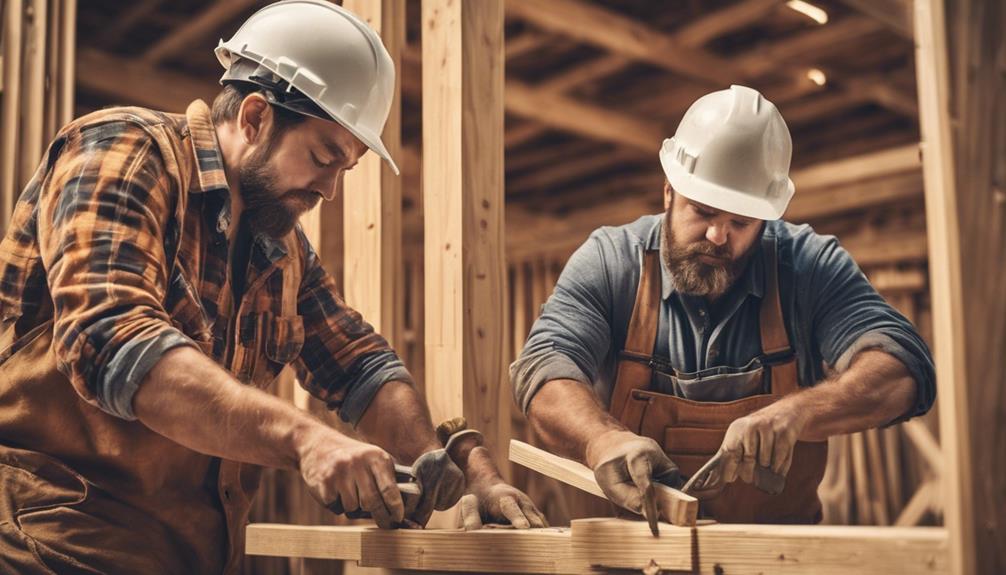
When evaluating wood building labor expenses, it becomes evident that the costs can vary significantly based on factors such as location, design complexity, and the skill level required for construction. Hiring skilled labor for wood building construction can increase overall labor costs substantially due to the specialized tools and equipment necessary for wood framing. Access to the construction site and the project timeline also play crucial roles in determining wood building labor costs. Wood structures demand meticulous attention to detail, which can extend the project timeline and subsequently increase labor expenses. Below is a breakdown of how various factors influence wood building labor costs:
| Factors | Impact on Labor Costs |
|---|---|
| Location | Proximity to suppliers and resources can affect costs. |
| Design Complexity | Intricate designs require more time and skilled labor. |
| Skill Level | Higher skill requirements often lead to increased labor expenses. |
Comparing Long-Term Maintenance Costs
In the realm of construction materials, considering long-term maintenance costs, the disparity between wood and metal structures becomes strikingly evident. Metal buildings, especially those made of steel, prove to be more cost-effective in the long run compared to wooden buildings. Steel structures offer resistance to rot, pests, and mold, significantly reducing maintenance needs over time.
Wood buildings, on the other hand, require ongoing maintenance such as painting and periodic roof replacements, leading to higher long-term costs. Metal buildings, known for their durability and low maintenance requirements, provide substantial lifetime savings due to their minimal upkeep needs. Steel structures, with near-zero maintenance costs, offer a compelling advantage in terms of long-term cost-effectiveness.
Additionally, metal buildings can be highly customizable, adding to their appeal for those seeking innovative and efficient construction solutions. Overall, when considering construction costs and long-term savings, metal buildings, especially steel structures, emerge as the more cost-effective choice over wooden buildings.
Analyzing Structural Strength Differences
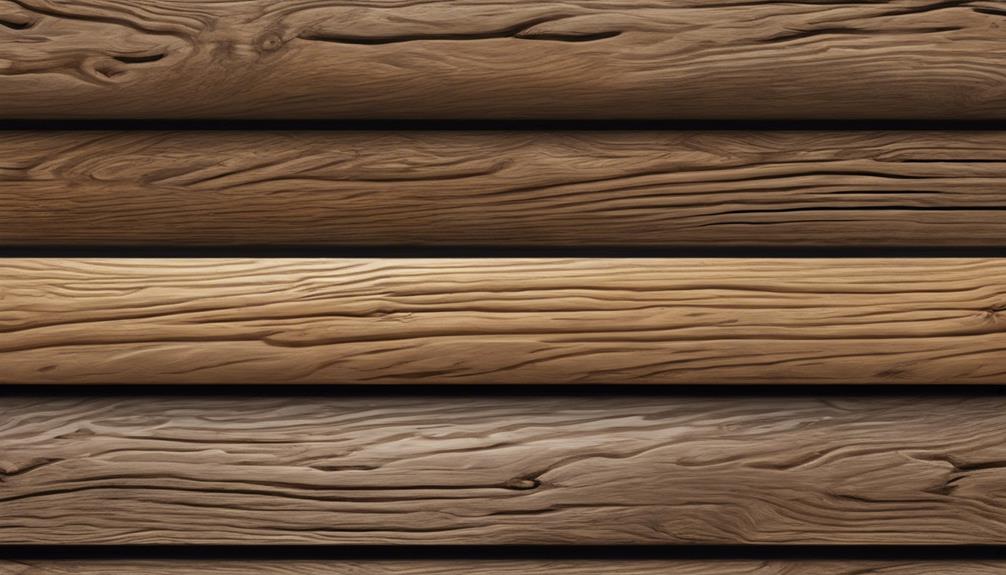
Considering the structural integrity of buildings, the disparity in strength between wood and steel becomes evident. Steel buildings, characterized by their robust nature, outshine wooden constructions in terms of structural strength. The load-bearing capability of steel structures far surpasses that of wood, making them more durable and resilient. Steel buildings exhibit heightened resistance to natural disasters such as hurricanes and fires, underscoring their structural prowess.
On the contrary, wooden buildings are more prone to warping, cracking, and decay over time, revealing their structural limitations when compared to steel. In terms of longevity and durability, steel buildings offer a superior lifespan, maintaining their structural integrity for extended periods compared to wood constructions. This stark contrast in structural strength between steel and wood showcases the advantages of opting for steel in building construction projects, especially when prioritizing resilience and longevity.
Assessing Customization and Environmental Factors
As we delve into the realm of assessing customization and environmental factors, it becomes evident that metal buildings offer a plethora of design options and sustainable advantages.
Metal buildings can be customized with facades, veneers, and cladding, providing a range of looks to suit various preferences. The versatility in design options allows for personalized customization, catering to individual tastes and functional requirements.
Moreover, steel, the primary material in metal buildings, is highly sustainable as it's the most recycled material globally, with buildings typically consisting of 50%-55% recycled content. Additionally, up to 90% of a metal building can be recycled, making them environmentally friendly choices.
Metal constructions can also incorporate eco-friendly solutions like solar panels, contributing to reduced energy costs over time. With their cheaper upfront costs, customizable features, and eco-conscious design elements, metal buildings emerge as a compelling option for those seeking both cost-effective and sustainable building solutions.
Frequently Asked Questions
Is It Cheaper to Build a Building Out of Wood or Metal?
Building with metal is often cheaper than using wood due to its lower maintenance costs and long-term savings. Steel structures may have higher upfront expenses, but their durability and minimal maintenance needs result in significant cost benefits over time.
Wood buildings, while initially less expensive, require ongoing upkeep like painting and roof replacements, making them less cost-effective in the long run compared to metal constructions.
Is It Better to Build With Wood or Metal?
When weighing the advantages of building with wood or metal, it's essential to consider factors like maintenance costs, durability, and construction speed.
Metal structures offer lower maintenance expenses, resistance to fire and pests, and quicker erection times.
Wood buildings, on the other hand, demand more upkeep but can provide a traditional aesthetic.
Ultimately, the decision hinges on priorities like long-term savings, durability, and aesthetic appeal.
Is It Cheaper to Build a Metal Garage or Wood?
We've delved into the costs of building a metal garage versus a wood one. Metal structures typically come out cheaper upfront due to lower material costs and the efficiency of steel building kits.
Additionally, maintenance expenses over time are often lower for metal garages, as they resist pests, rust, and mold better than wood. When considering long-term savings and durability, a metal garage might be the more cost-effective choice.
Is a Steel Barn Cheaper Than Wood?
Yes, a steel barn is generally more cost-effective than a wood barn. Steel barn kits average between $7 and $12 per sq ft, offering better value and durability than wood structures.
Lower maintenance costs and faster construction times make steel barns a practical and economical choice. With reduced labor expenses and long-term savings, steel barns prove to be a cheaper and efficient option over wood barns.
Conclusion
In conclusion, when weighing the costs and benefits of building with wood versus metal, it's clear that metal offers a more cost-effective solution in the long run. With lower maintenance costs, higher durability, and quicker construction times, metal buildings prove to be a wise investment for any construction project.
Choosing metal over wood is like building a sturdy fortress that withstands the test of time, ensuring a solid foundation for the future.
- About the Author
- Latest Posts
Introducing Ron, the home decor aficionado at ByRetreat, whose passion for creating beautiful and inviting spaces is at the heart of his work. With his deep knowledge of home decor and his innate sense of style, Ron brings a wealth of expertise and a keen eye for detail to the ByRetreat team.
Ron’s love for home decor goes beyond aesthetics; he understands that our surroundings play a significant role in our overall well-being and productivity. With this in mind, Ron is dedicated to transforming remote workspaces into havens of comfort, functionality, and beauty.
-

 Mardi Gras Decoration4 weeks ago
Mardi Gras Decoration4 weeks agoWhen Should I Decorate for Mardi Gras?
-
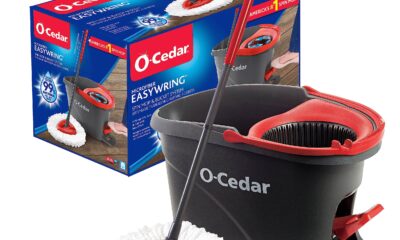
 Vetted2 weeks ago
Vetted2 weeks agoBest Mop for Sparkling Clean Floors in 2024
-

 Christmas Decoration4 weeks ago
Christmas Decoration4 weeks agoDoes Orthodox Christmas Have Santa?
-

 Christmas Decoration4 weeks ago
Christmas Decoration4 weeks agoWhat Happened to Christopher Radko?
-

 Christmas Decoration4 weeks ago
Christmas Decoration4 weeks agoWhat Is Coptic Christmas Day?
-

 Christmas Decoration3 weeks ago
Christmas Decoration3 weeks agoWhy Do Orthodox Have Christmas on January 7th?
-
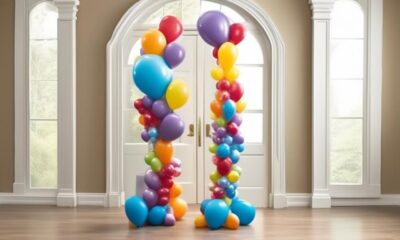
 Carnival Decoration3 weeks ago
Carnival Decoration3 weeks agoHow Tall Should a Balloon Column Be?
-

 Carnival Decoration3 weeks ago
Carnival Decoration3 weeks agoWhat Food Is Served at a Circus








